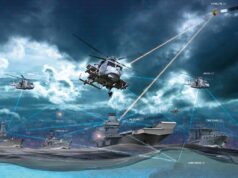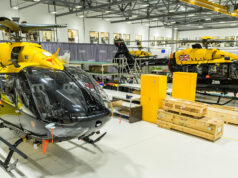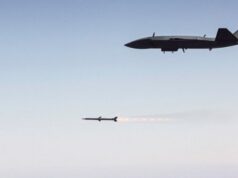A number of concepts will be explored as the Ministry of Defence looks to replace existing attack helicopters in the latter part of the 2030s and beyond to “deliver military effect in the land and maritime environments”.
The Ministry of Defence has published a ‘Prior Information Notice’ setting out
• Build on current research to mature and demonstrate technologies required by future tactical aviation to achieve Freedom of Action and Manoeuvre (FoAM) in a CDO environment. Key areas of potential interest are listed below.
This is an indicative list only and is not exhaustive; it is not a commitment that all of the topic areas listed will be exploited, and some additional topics may be identified as the project matures:
• In-cockpit assistance, autonomy, and automation of crew tasks which supports situational awareness, decision making and threat awareness during all phases of flight and while operating singly or in formations.
• The use of automation of tasks to enable a reduction in the number of crew required to operate future generation aircraft.
• Enablers for multi-domain teaming with aviation platforms to deliver find, attack and lift capabilities into the land and maritime environments.
• Communication concepts that enable timely and effective information exchange between platforms and systems into a fused information picture, thus improving battlespace awareness.
• Development of an evaluation environment that enables the integration and combined benefits of key enabling technologies to be demonstrated in a suitably representative CDO environment.
• Future force mixes & equipment to maximise effectiveness and deliver scalable integrated effects.
• Improved operational efficiency and capability resilience through digital engineering methods.
• Use of autonomy in optimising aviation force effectiveness and the people component of the force.
It is intended to conduct an Early Engagement event in mid-2022, hosted by Dstl, to provide an opportunity for interested Industry organisations to gain further information of the requirement and Dstl expectations prior to the formal tendering stage.
Other Similar Projects
The US Army’s Future Attack Reconnaissance Aircraft (FARA) programme comes to mind and a contender for that project (the Boeing offerig) is shown above as the cover image for this article. According to Air International, FARA falls under the US Army’s Future Vertical Lift project which is led by the service’s Futures Command.
“The competition seeks to design, produce and test a prototype that will fill a capability gap caused by the retirement of the army’s Bell OH-58D Kiowa Warrior light attack/reconnaissance helicopter fleet in 2017 – a gap which is currently being covered by AH-64D/E attack helicopters.”
You can read more on this by clicking here and I recommend that you do as the UK appears to be going in a similar direction, in my humble opinion. Earlier in the year, the US and British armies agreed to pursue a ‘Future Vertical Lift Cooperative Program Feasibility Assessment,’ aiming to ensure interoperability between their rotorcraft aviation forces in future.
With both nations planning to “share information about their future rotorcraft requirements and programs”, it’s not hard to imagine the UK going down the route of FARA and the specifications above appear to suggest something similar will, eventually, be looked at.













The MoD later released a statement saying “It will be a world beating platform supporting thousands of UK jobs – although due to budget constraints, we will only be buying a single airframe”
Defence Chiefs added (through gritted teeth) “This superb new aircraft will deliver enhanced lethality to whatever unit gets to use it this week”
And fitted for but not with pretty much everything it needs to save cost.
Buying five rotor blades to share across the fleet
I had those down as fitted for but not with.
To be fitted when the shit hits the fan and we need our one airframe to give the impression we are doing something.
You say this on every single post.
CBE
Means either:-
Can’t Be Everywhere; or
Can Be Everywhere?
And it’s “More agile”
Off-topic, but I thought you might be interested!
PGZ and MBDA sign agreement on Brimstone tank destroyers
19 MAY 2022
https://www.janes.com/defence-news/industry-headlines/latest/pgz-and-mbda-sign-agreement-on-brimstone-tank-destroyers
This subject is starting to rival your Typhoon thing!
Think he’s got shares £ with MBDA 😆
Any updates on Brigade numbers and what should be included in them!
Things like that Brimstone vehicle you keep reading me with! 😉
https://www.thetimes.co.uk/article/are-british-weapons-making-a-difference-in-ukraine-grdp9p8p5
classic! 😂
A bit like you Klonkie thanking Robert Blay for his informative posts 😂 Welcome to the real world!
The 600 plus that the F-35 was supposed to replace by the way.
“Let’s fast forward to the 2035/2036-ish timeframe. Is there still a need for that low-cost platform? I think, right now, there is,” he said. “And what does it look like? Do we replace it with another F-16-looking thing?
Did the F-35 come down in cost enough that we can buy more of them? Is it something else? Is it unmanned at that point, because we can do things differently?”
All of that, he said, is “a question for another day. The good thing is, we don’t have to do anything right now. We’ve got 18-20 years of life left on 600-plus F-16s that are doing great work for our nation.” The decision on how it will be replaced is “probably six, eight years away,” he said.
In the meantime, USAF can concentrate on “getting the F-35 right,” recapitalizing squadrons with F-35s and F-15EXs, and increasing the overall capacity of the force, while developing the “NGAD family of systems and upgrading the [F-22] Raptor in the meantime.”
The Air Force doesn’t have to make any decisions about a near-term, low-cost manned platform because it has the post-block F-16s, Nahom said. And, though he acknowledged the modifications are “expensive,” he said, “for what we’ll get out of that aeroplane, it’s well-spent money.”
https://www.airforcemag.com/f-16s-to-serve-nearly-two-more-decades-replacement-choice-still-6-8-years-away/
F-35 Program Stagnated in 2021 but DOD Testing Office Hiding Full Extent of Problem
“The F-35 Joint Strike Fighter program appears to be in a state of suspended development, with little progress made in 2021 toward improving its lackluster performance. The latest report by the Pentagon’s Director, Operational Test & Evaluation (DOT&E) reveals stagnation and even backsliding in some fleet reliability measures.
And that’s just the public DOT&E report.
In an unprecedented move, DOT&E is concealing many of the key details of the F-35’s poor performance. For the first time ever, the testing office created a non-public “controlled unclassified information” version of its report, and although there is much overlap between the two versions, the meaningful details about the ever-troubled program are only included in the non-public one.”
https://www.pogo.org/analysis/2022/03/f-35-program-stagnated-in-2021-but-dod-testing-office-hiding-full-extent-of-problem/
What..a whole😉airframe?
Unnecessary double spending while developing the Mosquito drone…
It makes more sense on a budget to focus more on medium and small drones.
But this isn’t just a future attack helicopter business, it’s a tax plan to maintain Britain’s helicopter industry or create more jobs.
= it may be screwed.
Just for the record what is actual wrong with the British government investing to ensure the U.K. has the industrial capability to defend itself.
Yes creat more jobs build our own stuff….where does the tax base to pay for our defence come from if we don’t actually create and invest in the high tech industries that will support our nation.
There were prerequisites.
A project must succeed or leave a legacy even if the project fails – the legacy must be applicable to other projects.
I think this project is what the MOD presents to Airbus – it could be a yeovil, but I don’t think it’s an unmanned helicopter that emphasizes autonomy . so not yeobil
Under the premise of Airbus, the MOD’s autonomy requirement standard is to improve survivability when a one-person pilot is operating, shooting, and autonomous operation when launching missiles.
There is no explanation as to whether this will proceed like Airbus’ open architecture project in the past, or whether it will just remain an Airbus property. – With a high probability, it will remain an Airbus asset.
Even if the source code is shared with the MOD, the “optimized:” source made with FPGA will have technical difficulties that are difficult to apply to other projects, and will inevitably entail reliance on “Mandarin” and high cost.
In such a situation, Airbus should have a technological element comparable to BAE in the field of military weapons technology, and it should be used on the battlefield.
Airbus is a huge airline and maybe it can be successful.
However, I think it is worth noting that this type of British taxpayer investment is provided for the convenience of businesses.
You mentioned job creation and industrial development.
However, there is no legacy left in the MOD that determines the actual capital investment and executes it on behalf of the British taxpayer.
As I said before, even if Airbus leaves a legacy, it will have to rely on Mandarin.
If the investment of capital that is absolutely necessary for MOD, it should be an investment, not a speculation.
The nurturing and maintenance of the legacy left in MOD and the British government and human resources to utilize it is an investment.
It is also a way to develop Britain’s industry and technology.
However, if MOD follows the way it used to be, it is considered speculation, not investment.
It’s just like praying that tomorrow’s weather will be clear.
Summary of my words:
The project must be an open architecture and the source code must be shared with the MOD. – In this process, whether airbus’ patented technology is used or not is a legal contract with the MOD, so it may not infringe the assets of airbus in a way that the MOD does not use.
– Many of the Fly by wire will fall under this, but it is clearly not based on the existing airbus patents; machine learning, information that corresponds to the driver that uses the board when using commercial hardware.
MODs should employ and retain manpower by investing at least 1/10 of the budget and resources to carry out this projects; Manpower who can understand and apply the task to some extent even if it is not directly put into the industrial field
Simply put, it’s easy to invest more in a Mosquito Drone without requiring special skills for a helicopter, which is expensive.
What skills do you need to operate (fly), service and re-arm such a drone?
Doesn’t look like it’s got much in common with the US programme. Theirs is for a lighter scout helicopter that would complement the Apache. Ours reads like it would be to replace the Apache itself.
Personally I’d be surprised to see the US programme come to anything, I expect that sort of role to be taken over by unmanned in the future.
We should pick Leonardo AW139 built in Yeovil and build the site up and then develop the AW609 tilt rota to a military version for naval use.
Sadly unless things change the latter cannot be used for military purposes due to licensing.
Agree, better to develop a civilian version of the Valor. As that has improved mechanicals, namely it doesn’t tilt the whole engine and gearbox like the AW609, just the gearbox. Therefore the aircraft will suffer less FOD ingestion and create less surface erosion when landing/taking off.
I would not be surprised if Bell have not at least computer modelled a larger version of the Valor around the same size as the Osprey. As the Osprey’s design brief placed a number of restrictions on the aircraft. Which decreased its performance ,,especially in the hover.
See link above
Thanks found this link which explains it’s origins.
Yes you are right but no one in the MOD has the sence to do that I am afriad.
Can’t the contract for aw609 precludes military or armed use so can’t compete with Uncle Sam
Mark the 139 is a civilian rotor and not the right kit for this. I’m all for supporting our industry and think we should be buying the 149 for meduim lift as it’s a great rotor..but this does offer some good development opportunities and support developing the tec base of our rotor industry.
Cheers Jonathan my sausage fingers struck again. I did mean the AW149.
The AW149. if it is picked will not be built at Yeovil. It will simply be made elsewhere and then assembled at Yeovil…
That does not lead to a factory and workforce that can design and build a next gen Helicopter…
Thanks for that info final assembly? Is that industry talk for a lick of paint. Itooks like a short deal for some Blackhawks doesn’t look that bad now untill the Yanks sort out the defiant. And we can get 3 specialist variants for each service. They even have a new pilotless system they are trialing. The Blackhawk maybe an old design like the B52 but it will bring so much commonality with our allies if they can get a good deal on them.
We need these 😀https://james-camerons-avatar.fandom.com/wiki/Scorpion_Gunship with this to replace PUMA’s etc https://james-camerons-avatar.fandom.com/wiki/Aerospatiale_SA-2_Samson
It is interesting that with all the talk of the MBT being obsolete based on the war in Ukraine there has been almost no talk about the role of attack helicopters in an environment where every Tom, Dick and Harry has a Stinger or equivalent. Or for that matter ATGM! They’ve suffered just as badly as MBTs and the Russians seem reluctant to use them near the front.
I am amazed that poorly designed Russian tanks, ineptly tactically handled by conscripts with low morale is evidence that the tank is obsolete in all armies of the world. Good point about the vulnerability of the attack helicopter to MANPADS. I wonder when anyone will start to talk about the vulnerability of: SP Guns; soldiers in soft-skinned vehicles; dismounted soldiers, aka anyone on the batttlefield.
To be clear I didn’t say they were obsolete, just commenting on the difference in the conversation. It’s interesting how much stick the MBT has got while Russian helicopters are having just as bad a time and are relegated to being pseudo-artillery well behind the front lines, and this doesn’t seem to be being talked about.
The proliferation of MANPADS seems to have neutered them in Ukraine. Unlike Russia we have plenty of PGM so Western fast jets aren’t as troubled by VSHORAD systems, but it looks like it could really hurt attack helicopters in the future.
Apologies Magnus. So many commentators delight in talking about MBTs as being obsolete.
I hadn’t heard that the Russians had lost a huge number of attack helicopters. They have lost just 5 Mi-24.
https://en.wikipedia.org/wiki/List_of_aircraft_losses_during_the_Russo-Ukrainian_War
There has been no rumours or news of an Apache replacement, which strikes me as odd. The reason why I say this, is based on the US Army’s future medium lift program. Both of the contenders have a significant speed and range advantage over the Apache. Which by most of today’s helicopter speeds is quite slow. Therefore if they need escorting in a future scenario, they will have to slow down, a lot!
The FARA program I can understand, as its mission is purely scout and reconnaissance. Even it won’t be able to keep up with the SB1 or Valor. So where is the Apache replacement? Perhaps the MoD have released this as they know the US Army are looking at something. As both Sikorsky and Bell have depicted gunship versions of the SB1 and Valor.
Seems using FLRAA as an attack platform, not just for assault, might be the Apache replacement.
The reasoning might be that both future attack and future reconnaissance helicopters will be using smart weapons, targeted by infantry, ALE UAS launched from FLRAA or launched from FARA, or with target designation directly by FARA. This avoids the attack platform being as exposed as when using chain guns or rockets in line of sight.
This conops would seem to make sense when we see static helicopters bought down by ATGM (let alone manpads) and helicopters launching rockets on ballistic profiles to avoid manpads, both demonstrated in Ukraine.
I wonder if this will be a future option?
“There is the NATO group called Next Generation Rotorcraft Capability discussing what should be the specifications for utility helicopters beyond 2035, and this group has put a strong emphasis on speed,” Louvot said on 18 May.
“Speed is the defining factor, and what stands out, with implications for the aircraft architectures, is the request for a cruise speed of 220 kt, which basically says that it cannot be a conventional helicopter – it must be a different architecture.”
A model of the Airbus RACER concept, showcasing the pusher-propeller configuration that should enable it to achieve the high-speed flight required of the NGRC requirement.”
https://www.janes.com/defence-news/defence/latest/ngrc-need-for-speed-to-drive-unconventional-rotorcraft-design
Or possibly this?
“A new high-speed helicopter being developed by Korean Aerospace Industries (KAI) intends to replace Sikorsky UH-60 Black Hawks in service with the Republic of Korea (RoK) Armed Forces.
Designated as the ‘next-generation high-manoeuvre helicopter’, an industry source told Janes that KAI is conducting research and development of the new air platform.”
https://www.janes.com/defence-news/news-detail/kai-developing-next-generation-high-speed-helicopter
As per the Sikorsky SB1, it will use brute force to get above 200 knots. What the aircraft will do is reduce the forward pitch of the blades that is used to generate thrust, i.e. pushing the air backwards. Instead it will reduce the blades pitch angle as it goes faster. As the thrust will be generated by the propeller. As the aircraft goes faster the rotors even though at aa lower pitch angle will generate more lift. However, to go faster still they will have to slow down the rotor rpm, as the tip speed enters the transonic zone and start to loose lift. If they go supersonic the blade which is designed to be flexible to remove some of the shock loads when carrying underslung cargo will oscillate out of control catastrophically. The Airbus Racer is a better solution.
Many thanks for your detailed analysis Daveyb, there are some fascinating concepts around, and I hope we eventually make the right choice!
looks like a dropped RAH-66 Comanche rework
RAH 66 had a traditional rear rotor.
You mean this bad boy.
Yes
The Racer which is based on the research and trials of the X3 prototype, is in my opinion, the better and more elegant solution for cracking the 200 knot limit that helicopters in general have. The X3 being a heavily modified Dauphin helicopter, still managed to crack 255 knots in level flight. The Racer should be better, as its a clean sheet design.
The aircraft is in all intents and purposes a convertiplane (but not quite!). By this I mean it powers the rotor head conventional during vertical take-offs, landings and in the hover. But in forward flight as soon as the wings develop enough lift, the main rotor rpm is reduced. This has the effect of slowing down the rotor blade tip speed. The rotor head pitch angle is reduced, so its no longer developing thrust pushing air backwards. As the thrust is produced by the two propellers. By using differential thrust, the two propellers can also control the aircraft’s yaw.
However, unlike a true convertiplane, some power is still provided to the rotor head. In the X3, the rotor rpm only dropped to 80%. Looking at the Racer, it has a bigger wing area, so the rotor rpm may be dropped further. Which means it could fly faster before the blade tip speed becomes an issue again. If power is completely removed from the rotor head, then the oncoming air turns the blades as per an autogyro. The rotor blades are therefore turning at the local airspeed and the tips should just be a bit faster. Thereby allowing the aircraft to fly much faster, comparable with a tilt-rotor.
Westlands (Leonardo) have had the answer since the early 1960’s, when the took over Fairey.
Nothing prevents putting wings in Sikorski.
For me it is the most logical proposition without cumbersome/more weight change of fuselage geometry for storage like V-280, the Airbus racer have those wings that limit people access to cabin, visibility. I think it is better than the V280 weight wise, but limits its storage.
Instead the Sikorski in theory seems the design that best preserves the size advantage of helicopters over convertiplanes.
To store into a frigate hanger or inside a big cargo plane there is need only of rotor blades being flipped.
Agree to a point, Sikorsky could add a set of wings. But they would then have to reduce the power to the two co-axial rotor heads. Where the wings will offset the loss of lift from the slower turning rotor blades. They can’t reduce it too much, as co-axials use differential collective pitch movement to control yaw. They would also add a moving tail as this would be used over speeds of 100 knots. The flight control laws would need amending as well. But it is definitely doable and would allow the aircraft to fly faster.
The Defiant, I think is the best suited aircraft or the US Army as a replacement for the Blackhawk. It will be much more manoeuvrable at low heights when flying nap of the earth (hedge hopping) when approaching hot drop zones. The Army had stated that the replacement aircraft must have a footprint no bigger than the Blackhawk. The Valor doesn’t really meet that requirement, depending how you interpret the requirement. Cabin size, landing gear footprint and overall length does. But I believe when the rotors are tilted vertically, the prop rotor diameter is slightly wider than the Blackhawk’s rotor disc diameter.
The Valor, would be the best aircraft for replacing the USMC Hueys in the long-range assault role. It has the added range and speed needed for operating in the Pacific theatre. There’s nothing worse than sitting in the back of a Chinook for 6 hours travelling only at 150 knots, then having to refuel at every stop taking forever to get anywhere. It’s worse in a Blackhawk, as even with ferry tanks it can only do about 3 hours of flying before needing to refuel.
The Racer has used a merging biplane arrangement for the wings. This has the advantage of keeping the wingspan short, whilst giving the necessary area to generate lift. Though where the wings come together abruptly at the engine, will cause turbulence issues. In its current guise, it is probably not best suited for a military aircraft.
It would be relatively easy to design a military version of the Racer. If it included a tail ramp, much like the NH90’s. You can parachute from it more safely, fast rope and use a recovery ladder. It also speeds up egress when landed. With cabin doors in front of the wing and using pusher propellers, means troops can approach the aircraft more safely from the sides. Plus, you have an area where a gunner can be placed for ground suppression with a crew served weapon.
Airbus could build a decent aircraft based on the Racer platform to replace NH90, Cougar and Super Pumas. It could be an aircraft that competes equally with the US offerings.
Nice post DaveB. The Valor concept means that when landing it takes more space since there are 2 rotors footprint – albeit smaller.
Yeah in terms of disadvantage for Sikorski is that the concept prevents the rear ramp.
MOD must be high again.
Concept my… eye! That ‘model’ came out 15+ years ago as an Action Man vehicle!
Just an observation that the UK is almost two years into a formal relationship wrt FLRAA and FARA. https://breakingdefense.com/2020/07/us-uk-ink-pact-on-next-gen-aircraft-precision-weapons/
Of note to some concerned about our artillery capabilities might also be the interest in the Precision Strike Missile (PrSM) launched from wheeled HIMARS platforms as part of that same agreement. Which might suggest additional rocket artillery platforms, beyond the current commitments to upgrading existing tracked MLRS platforms. PrSM is expected to have a 500km+ range.
Can we not just buy these and then modify them for our own needs ?
https://www.youtube.com/watch?v=yuStvGT1aFA
Can I make a prediction…..we will spend a few billion on this, then just end up buying what the Americans are replacing the Apache with…
Yes I did wonder why we’re not saving our limited resources & going American. Better buying a few more Apaches now to ensure we have enough.
It’ll be another hugely complex, protracted and expensive procurement process only to end up buying whatever the US selects as its Apache replacement. I still remember talking to a Dutch MOD person, when I was at Westland, regarding the original Apache procurement. He said something along the lines of “I see it’s taken you many years and hundreds of personnel to arrive at the same decision that took us a few months and an equally small number of people”.
Nice graphic, total wast of money that we should be investing in something else.
when will the MOD learn
What should we be investing in?
Why not concentrate on tempest, which we will need every penny for.
Or actually use the money wasted on this to buy mk41 cells
Or given the likely explosion in drones perhaps we should get our excellent aerospace industry coming up with something to rival the Turkish drones being used in current conflicts.
The reality is there are loads more stuff we should invest in where we can reap the benefits of mass.
We will never see a return on this vestment ordering 50 helicopters… which we will end up buying from the US
Where is Taranis? £180m invested where is the output?
Thanks mate.
Why do future helicopters still have tail rotors rather than NOTAR designs.
Great point. I didn’t know this existed, having read up on it it does seem to be a good solution for military helicopters in particular
Probably for the same reason why helicopters still use the traditional main rotor and tail rotor configuration, rather than a co-axial one, even if it’s shown that a co-axial one is more efficient despite the increased complexity.
The NOTAR MD500 was shown at Farnborough years ago. I remember watching it, but couldn’t hear it. Until it started beating up the flight line. It seemed to be just as aerobatic as the standard 500, just a heck of a lot quieter.
This is what surprises me, the 160th SOAR use the MH500 Little Bird. They use for covert insertions in urban areas. It went from a four, to a five and now a six bladed main rotor to enhance its quietness. But it still has a tail rotor, that went from two, then to four and relatively recently to a four scissor bladed tail rotor. The tail rotor is still the main generator of noise. The NOTAR would solve a lot of problems for covert operations..
The MOD would be better off exploring where the money for this would come from and then buying American.
Just what we need – more research into esoteric new concepts! Wow.
Meanwhile Yeovil is running out of work and no one has actually ordered the new medium copter yet